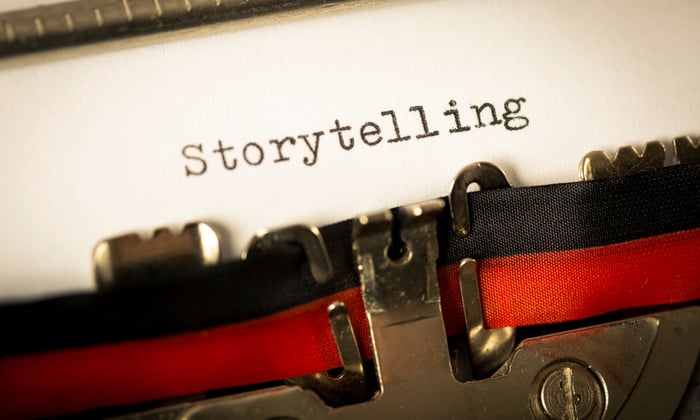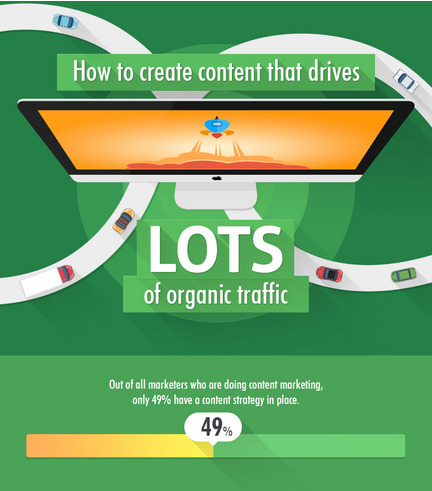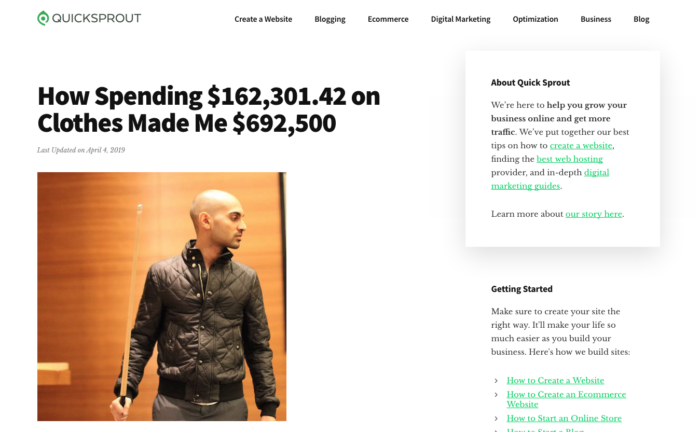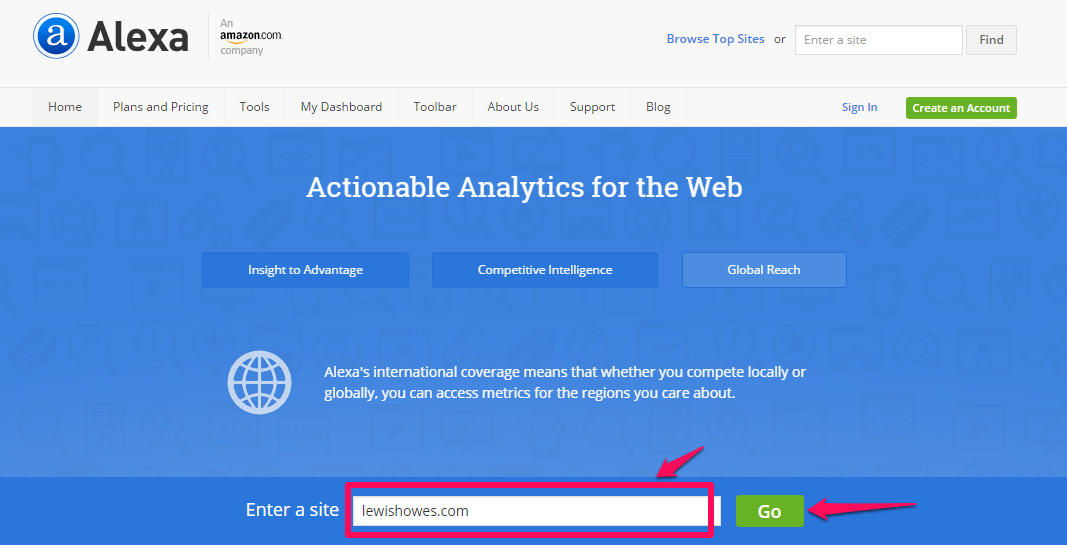
In the not so distant past, I embarked on a journey to grow NeilPatel.com to 100,000 blog readers. At the end of every month, I shared my traffic stats and the changes I’d made. That storytelling strategy went on to help my blog reach over 100,000 views a month — in only about eight months.
As marketers, we use storytelling to help make our ideas stick. We create stories to help prospects understand our products, use company stories to build trust and transparency with consumers, and include stories in sales pitches to help persuade.
Why does it work?
Competition in native advertising and social media marketing is fierce. And, the rate at which great content is being produced and published on the web and across the media channels is expanding. Our readership is drowning.
Most people scan web content, looking for something that stands out. If they don’t find it, they’ll leave.
Visual stories and corporate storytelling can connect the dots and get people to ACTUALLY read your great content and take action. This is the essence of successful media marketing.
If you want to increase your potential customer conversions, then start captivating your target market by making emotional connections through storytelling.
Storytelling is like a vitamin. When it gets into your readers, it permeates their whole being and fights every objection that might otherwise stop them from becoming loyal customers.
In short, it’s an amazing secret weapon when it comes to your marketing strategy.
In this article, I’ll explain the five simple steps you can improve your potential customer conversion rate by combining storytelling and data.
The breakdown of what you’ll learn is:
- What Storytelling Is
- The Elements of Storytelling
- How to Use Storytelling to Increase Conversions
- Build Authority Through Storytelling
- Storytelling Success Stories
Step #1: What is Storytelling?
Storytelling is the art of communicating your idea, message or event, by creatively weaving words, images, and sounds into a narrative. Visual stories, written stories, and verbal stories – this is the content we love.
When you tell a true story, your message is perceived as authentic. In the same way that live events get more retweets than general tweets on social media channels, your content will impact the lives of your target market, and improve your credibility.

Why should you use corporate storytelling in content marketing? We breathe visual stories. Even in the Stone Age, humans understood how to tell stories that evoked interest and made that emotional connection.
And, it’s one of the most effective ways to engage and persuade your audience.

Humans are born storytellers and adore visual communication. Storytelling gives life or meaning to a scenario and makes that emotional connection, provoking feelings of ecstasy, sorrow, or peace, and captivating your audience. This is exactly what you need when it comes to your digital marketing strategy.
It is little wonder that posts with visual stories and visual communication generate more Facebook and media channel shares than any other content type.
As it turns out, visual stories and communication (e.g., infographics, videos, memes, screenshots) get widely shared on major social media channels.

Your potential customers aren’t looking for another sales pitch or a proposal that sounds too good to be true. They’ve heard enough of those.
For example, when you write, use relevant images and great visual stories that pique people’s interest.
Or, if you’re recording a podcast, you could use emotion-triggering music and sounds. For video creation, you can use words, images, visual stories, and sounds at the same time.
A study conducted by Forrester Research found that 88% of executives and organizational decision-makers long to have conversations, not pushy sales presentations.
With visual stories, you can create and promote infographics, which have collectively generated over 2,500,000 million visitors and 41,142 backlinks for me, over a two-year span.
I usually publish new infographics every Friday, and the results have been amazing.

You can also create visual stories and content and submit it to authoritative media sites and platforms, such as Slideshare, Vimeo, and Animoto. This helps you gain a new target market and potential customers for your business.

Corporate Storytelling in Persuasion
Persuasion is the master key that will unlock your conversion vault with your potential customers. Robert Mckee was right when he said that “Storytelling with persuasion trumps statistics.”
Marketing is for people, and people are emotional beings.
Our brains are wired to respond to emotional connections and triggers. Storytelling is the most natural source of those triggers.

When you understand how to persuade others, you’ll no longer struggle to get more traffic. Instead, you’ll focus on improving conversions, because that’s what matters.
So, how do stories persuade a targeted group of readers or potential customers to take action? That’s the goal of setting up a content marketing strategy and writing in-depth content.
Moment of truth: What potential customers perceive to be true will ultimately guide their actions and decision-making processes. Consumer perceptions may or may not be accurate, but they’ll live by them, nevertheless.
When people visit your website or your media sites, what truth do you instill in them? Do you give visitors the hard sell, when they’re still trying to get to know you?
Instead of starting with “once upon a time,” or some variation of it, weave your story into your content. Stories can even appear on your headline, introduction, and, most importantly, on your landing page.
Add experiences, case studies, research studies, and significant results that you’ve helped your customers achieve. These are the foundation of your story.
I’ve used storytelling in the past to engage my readers, as well. For example, I shared a story on how spending $162,301.42 on clothes made me $692,500.

Personality: The Norwegian author Rune Belsvik once said that the concept of story was “one of the first things that came to the world.”
Our personality is born out of stories. We’re created to share and listen to stories, to fall in love with visual stories. So, storytelling is a natural tool to help grow your audience and increase your conversions.
In the same way, storytelling gives your content new flavor and amplify its benefits, because it’s coming from a “personality” – a set of characteristics that makes you special and appealing to others.
In the beginning of your content, open strong, and establish your story. In the middle, build interest in the message.
Highlight the benefits of the topic and close with a call-to-action that’s persuasive, not pushy.
David Siteman Garland, founder of The Rise To The Top, uses this strategy to write his copy. He starts out his story on a strong note, gradually evokes interest by showing the results in the middle, then calls his readers to action at the end.
Here’s the beginning:

Here’s the middle of his copy, where David builds interest through success stories:

And finally, the call-to-action at the end:

Note: Established bloggers and internet marketers who have built solid businesses use content segmentation to improve their conversion rate. And, because they’re creative at storytelling, they’re able to experience greater levels of success.
The sooner you master the art of storytelling, the better for your brand and online business. Social media is redefining storytelling in a significant way. Know your audience and be authentic in your written and visual stories.
You’ve already gone through a lot in life and have endless stories to share.
I don’t believe that you should make up stories; instead, you should tap into the wealth of stories from family, friends, customers, entrepreneurs, and brands.
Then, align those stories to the audience you’ve come to know like the back of your hand.
Step #2: Learn the Elements of Storytelling
When you’re telling or sharing a story with your potential customers, you want to achieve a specific outcome.
You want enough general knowledge to take your content marketing efforts to the next level. Then, make sure to include the following elements of storytelling.
A Defined Target Audience
Have you defined your audience yet? Before you can successfully tell a story, there must be a qualified audience to enjoy it. Most people get it backwards, if they do it at all.
But, you have to define your target audience first, because they’ll, in turn, define your product both in and out of social media marketing.
As time goes by and you build relationships and engage with your potential customers and target audience, they’ll send you great feedback that will help define and improve your product.
So, how do you define your target audience and your potential customers clearly? There are several ways to go about it, but I’ve personally found that demographics are the first step.
If I can truly understand who my target audience is and where they’re browsing my site from, I can align my content and tell a better story.
Your audience demographic is just a market segment, but it will give you a great understanding of their complete persona or profile.

Here are the four simple steps to define your audience, based on demographics:
Go to Alexa.com. Type in your site URL (e.g., lewishowes.com) and click “Go.”

To find your results, scroll down the Alexa result page and you’ll find this:
No comments:
Post a Comment